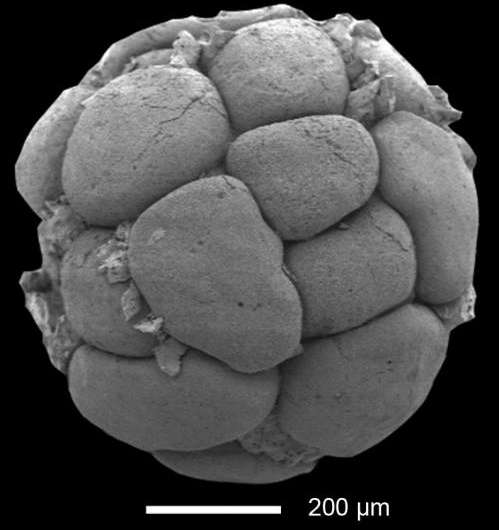Scientists review early evolution of eukaryotic multicellularity

The ascent of multi-celled life or multicellularity is a major evolutionary transition. Multicellularity evolved independently at least 25 times among eukaryotes, and complex multicellularity (characterized by intercellular communication and tissue differentiation controlled by regulatory gene networks) occurs in a handful of eukaryotic groups including animals.
The repeated evolution of multicellularity implies significant adaptational advantages of being multicellular, but the evolutionary steps toward complex multicellularity have not been completely understood, particularly from the paleontological perspective.
Preserved fossils from approximately 600-million-year-old rocks of the Doushantuo Formation in the Weng'an area of South China offer an opportunity to study the evolution of complex multicellularity in the fossil record. In a new study presented in the Beijing-based journal National Science Review, Virginia Tech geobiologist Shuhai Xiao and his co-authors review fossils from the Weng'an biota help to illuminate the evolutionary transition into complex multicellularity in several eukaryote groups, including red algae and animals.
Modern red algae are aquatic and photosynthetic organisms, mostly marine seaweeds. The majority of modern red algae are multicellular with cell differentiation, thus reaching the evolutionary grade of complex multicellularity.
Some form a thin sheet of tissue, as in Porphyra, which is used today in wrapping sushi. Others have calcified cell walls, as in coralline red algae, which live in coral reefs and contribute to reef construction in important ways.
Red algae from the Weng'an biota show evidence of cellular, tissue, and reproductive differentiation, and some are remarkably similar to modern coralline red algae. Unlike modern coralline red algae, however, those from the Weng'an biota are not calcified. Thus, they probably represent close evolutionary relatives of modern coralline red algae and they predate the rise of biomineralization in the corallines.
The Weng'an biota is best known for its animal embryo-like fossils. These fossils look similar to blastulas, which are animal embryos of an early developmental stage. Like modern animal embryos, the Weng'an blastula-like fossils show evidence of rapid cell divisions with little growth in between. However, because the adult animals of these Weng'an embryos have been elusive, these fossils have also been interpreted as bacteria, unicellular protists, or algae.
To test these different hypotheses, Xiao and his collaborators have been searching for more advanced developmental stages of these Weng'an fossils. Their new discoveries suggest that these blastula-like fossils are clearly multicellular. They likely had adhesion proteins to hold their cells together; they had specialized reproductive cells that are distinct from somatic cells; and they probably had programmed cell death, while their cells lacked a rigid cell wall.
The combination of these features, according to the authors, can rule out bacterial and protist interpretations of the fossils.
Professor Xiao, along with co-authors Xunlai Yuan and Chuanming Zhou of the Nanjing Institute of Geology and Paleontology, write in their new study, "The Weng'an biota and the Ediacaran radiation of multicellular eukaryotes," that the blastula-like fossils from Weng'an likely are close relatives of animals, but are cautious not to rule out the possibility of an algal affinity.
They advance the position that the long march toward animal multicellularity took many evolutionary steps. These evolutionary steps can be retraced only by investigating the intermediate forms preserved in the fossil record, because the closest living sisters of animals are rather simple unicellular organisms. Recognizing such intermediate forms, however, can be challenging because they can appear alien in the eye of any beholder who is trained to look at modern animals.
More information: Shuhai Xiao, A. D. Muscente, Lei Chen, Chuanming Zhou, James D. Schiffbauer, Andrew D. Wood, Nicholas F. Polys, Xunlai Yuan. "The Weng'an biota and the Ediacaran radiation of multicellular eukaryotes". National Science Review, nsr.oxfordjournals.org/content/1/4/498.full
Provided by Science China Press




















